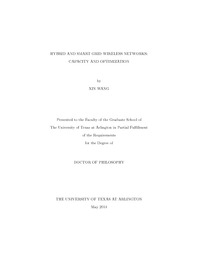
ATTENTION: The works hosted here are being migrated to a new repository that will consolidate resources, improve discoverability, and better show UTA's research impact on the global community. We will update authors as the migration progresses. Please see MavMatrix for more information.
Show simple item record
| dc.contributor.author | Wang, Xin | en_US |
| dc.date.accessioned | 2014-07-14T20:31:21Z | |
| dc.date.available | 2014-07-14T20:31:21Z | |
| dc.date.issued | 2014-07-14 | |
| dc.date.submitted | January 2014 | en_US |
| dc.identifier.other | DISS-12593 | en_US |
| dc.identifier.uri | http://hdl.handle.net/10106/24495 | |
| dc.description.abstract | Hybrid wireless network is a combination of ad hoc network and cellular network. A key question arising in such hybrid wireless networks is what is the per-node data transmission limit of the hybrid wireless network over general fading channels and how the throughput capacity varies with different network setup. To our best knowledge, our research is the first piece of work in literature to take up this challenge. To achieve the maximum per-node throughput, an opportunistic communication strategy together with successive interference cancelation (SIC) technique is proposed in this dissertation. The scaling laws for the throughput capacity over both slow fading channels and fast fading channel are derived, and the closed-form analytical expressions for the outage throughput capacity and ergodic throughput capacity are provided. Our research applies an information theoretic approach to determine the threshold of the data transmission rate in hybrid wireless network.Wireless sensor and actuator networks (WSANs) are applied into microgrid to stabilize the power supply in smart grid. In this dissertation, several sensor selection schemes are heuristically proposed to improve the voltage measurement performance and prolong the sensor network lifetime. First, aiming to accurately monitor the real-time voltage level, we propose an opportunistic sensor selection scheme under equal power allocation and investigate the asymptotic behaviors of the voltage measurement performance. We further address the sensor selection scheme under optimal power allocation. Besides, we present the studies on improving the power efficiency with the aid of voltage sensor selection.As a paradigm of the incoming smart grid, vehicle-to-grid (V2G) has been proposed as a solution to increase the adoption rate of plug-in hybrid electric vehicles (PHEVs). In this dissertation, we investigate the energy management strategies for PHEVs via bidirectional V2G. We first follow a cost-conscious approach from the PHEV owner point of view. We prove that a state-independent four-threshold feedback policy is optimal for PHEV battery charging/discharging based on stochastic inventory theory. Further, from the distribution system operator point view, we aim to shave the peak load and flatten the overall load profile. To this end, we propose an optimal PHEV charging scheme and derive a reminiscent of "water-filling" solution.Finally, based on the present researches on the capacity and optimization of hybrid and smart grid wireless networks, we propose two future research directions. First, we propose the future works about the throughput capacity of hybrid wireless networks with hexagon cell structure and Poisson Point Process (PPP) distributed base station. Second, we discuss the future research topic on the throughput capacity of cooperative-diversity networks over fading channels. | en_US |
| dc.description.sponsorship | Liang, Qilian | en_US |
| dc.language.iso | en | en_US |
| dc.publisher | Electrical Engineering | en_US |
| dc.title | Hybrid And Smart Grid Wireless Networks: Capacity And Optimization | en_US |
| dc.type | Ph.D. | en_US |
| dc.contributor.committeeChair | Liang, Qilian | en_US |
| dc.degree.department | Electrical Engineering | en_US |
| dc.degree.discipline | Electrical Engineering | en_US |
| dc.degree.grantor | University of Texas at Arlington | en_US |
| dc.degree.level | doctoral | en_US |
| dc.degree.name | Ph.D. | en_US |
Files in this item
- Name:
- Wang_uta_2502D_12593.pdf
- Size:
- 1.175Mb
- Format:
- PDF
This item appears in the following Collection(s)
Show simple item record


